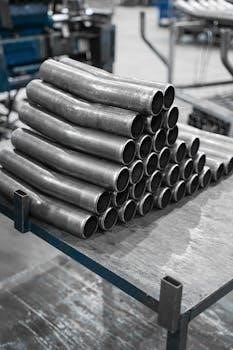Mechanics of Materials 11th Edition PDF⁚ Overview
The 11th edition of “Mechanics of Materials” is renowned for its clear presentation of theory and applications. It offers a thorough exploration of mechanics principles, incorporating visual aids and a variety of problem types to enhance student understanding.
Key Features of the 11th Edition
This edition is distinguished by its focus on clarity and a thorough presentation of the theory and application of mechanics of materials principles. The text empowers students to succeed by drawing upon Professor Hibbeler’s decades of classroom experience and his knowledge of how students learn, providing highly visual and methodical applications. The 11th edition incorporates several updates designed to enhance the learning experience. It includes approximately 430 problems, with roughly 30 being new, that involve applications to many different fields of engineering. A variety of problem types are presented, stressing realistic situations encountered in the field, with multiple levels of difficulty. This ensures students have ample practice to excel in their courses and career. The text is also shaped by the comments and suggestions of hundreds of reviewers and students.
Hibbeler’s Approach to Teaching
Hibbeler’s teaching approach in the 11th edition is marked by a clear and methodical presentation of mechanics of materials principles. Drawing from his extensive classroom experience and understanding of student learning, he provides highly visual applications. This enables students to conceptualize and master challenging concepts effectively. His method emphasizes problem-solving through realistic situations encountered in the field, using a variety of problem types with varying difficulty levels, which are designed to help students build their skills. This ensures that students not only grasp the theoretical aspects but also gain the practical experience needed for their engineering careers. The text is also shaped by feedback from reviewers in the teaching profession and many of his students.

Content Coverage
The textbook thoroughly covers stress analysis, strain analysis, and the mechanical properties of materials. These core topics are presented with clarity, ensuring a deep understanding of the subject.
Stress Analysis
The 11th edition dedicates significant attention to stress analysis, beginning with an introduction to the fundamental concepts of stress and its relationship to equilibrium within a deformable body. The text delves into the calculation of average normal stress in axially loaded bars, covering practical applications of average shear stress. Furthermore, it explores allowable stress design and limit state design, offering a comprehensive understanding of how stress analysis is applied in engineering practice; This section also examines how the material’s properties and external loads interact to create stress within a structural member, providing students with the fundamental tools to analyze structural integrity. The concepts of internal force and their relation to stress are covered extensively, emphasizing their importance in the context of design and safety assessment. This thorough approach ensures that students are well-versed in the theoretical foundations and practical applications of stress analysis.
Strain Analysis
The 11th edition provides a detailed exploration of strain analysis, starting with the foundational concept of deformation and its connection to strain. This section meticulously covers the different types of strain, such as normal and shear strain, and elucidates how they relate to the deformation of materials under load. The text includes discussions of the strain transformation equations, enabling students to analyze complex strain states. Emphasis is placed on understanding the geometrical changes in a body caused by external forces, and how these changes are quantified by the concept of strain. Furthermore, the relationship between stress and strain is examined, laying the groundwork for subsequent studies of material behavior. This thorough approach enables students to understand the fundamental principles of strain analysis, equipping them with essential tools for practical engineering applications.
Mechanical Properties of Materials
This section of the 11th edition delves into the critical mechanical properties of materials, which are essential for understanding material behavior under different loading conditions. The text provides an in-depth look at concepts such as stress-strain relationships, elasticity, plasticity, and material failure. It also explores different material behaviors, including ductile and brittle characteristics and the effects of temperature on mechanical properties. The discussion includes a detailed examination of the tensile test and the properties that can be determined through this experiment, such as yield strength, ultimate tensile strength, and modulus of elasticity. Additionally, the book covers topics like hardness and fatigue, providing students with an understanding of various material responses. These concepts are vital for making informed decisions in the design and analysis of engineering structures. The text aims to give a full understanding of material properties necessary for practical engineering work.

Problem Solving and Applications
The 11th edition excels in problem-solving, offering diverse realistic scenarios. It includes numerous problems, around 430, with varying difficulty levels, covering applications in different engineering fields.
Variety of Problem Types
The 11th edition of “Mechanics of Materials” distinguishes itself through the breadth and depth of its problem sets. Students encounter a wide range of problem types designed to simulate realistic engineering challenges. These problems vary in complexity, ensuring that learners at all levels can find suitable exercises to test their understanding. From fundamental concepts to advanced applications, the problems cover a broad spectrum of topics. This approach allows students to develop a robust problem-solving methodology, preparing them for both academic and professional challenges. The problems are meticulously crafted to reinforce theoretical knowledge and develop critical thinking skills, enabling students to tackle complex engineering problems with confidence. This variety is a key element in mastering the material presented in the textbook, making it a very effective learning resource.
Real-World Engineering Applications
The 11th edition emphasizes the practical relevance of mechanics of materials by incorporating numerous real-world engineering applications. These applications demonstrate how the theoretical concepts learned in the classroom directly apply to solving practical problems faced by engineers. By presenting examples from various engineering disciplines, the textbook illustrates the versatility and importance of mechanics of materials in different fields. These examples not only enhance understanding but also motivate students by showing the real-world impact of their studies. This approach ensures that students grasp the theory and develop the ability to apply it effectively in practical scenarios. The emphasis on real-world applications bridges the gap between theory and practice, preparing students for the demands of a professional engineering career. The book empowers students with the practical knowledge necessary to excel.
Number of Problems in the 11th Edition
The 11th edition of “Mechanics of Materials” offers a substantial number of problems designed to provide students with ample practice and reinforce their understanding of the concepts. The textbook includes approximately 430 problems, encompassing a wide array of difficulty levels and applications. This extensive collection of problems ensures that students have sufficient opportunities to hone their problem-solving skills. The problems are carefully selected to cover various topics within mechanics of materials, allowing students to apply their knowledge in diverse scenarios. The variety of problem types and difficulty levels cater to different learning styles and ensure that students are challenged appropriately. This large number of problems allows students to master the subject and prepares them to handle the complexities they will encounter in professional engineering practices.

Editions and Availability
The 11th edition is available in both standard and SI units. It is accessible through various platforms including digital formats. This edition can be found at multiple online bookstores.
SI Edition Details
The SI edition of the “Mechanics of Materials,” 11th edition, presents all content using the International System of Units, catering to a global audience and ensuring consistency in engineering calculations. This version includes approximately 30 new problems, expanding the range of applications across diverse engineering fields; It maintains the same clear and methodical approach as the standard edition, emphasizing visual learning and practical problem-solving. Furthermore, the SI edition mirrors the structure and content of the original, offering a seamless transition for those familiar with the textbook’s pedagogy. The consistent use of SI units throughout the text aids in standardizing engineering practices worldwide and facilitates a deeper understanding of the underlying principles. This edition is an essential resource for students and professionals working with SI units.
Availability of the 11th Edition in Different Formats
The 11th edition of “Mechanics of Materials” is available in various formats to accommodate diverse learning preferences and accessibility needs. Besides the traditional printed textbook, it can be found as a PDF ebook, allowing for easy digital access on multiple devices. Pearson also offers the eText version, which includes interactive features such as customizable search, flashcard creation, highlighting, and note-taking tools. This digital format also includes a mobile app, enabling students to learn both online and offline. The availability of the 11th edition in these multiple formats ensures that students can choose the option that best suits their study habits and technological resources. Each format maintains the same core content and structure, providing a consistent learning experience across all platforms.
Where to Find the 11th Edition
The 11th edition of “Mechanics of Materials” can be located through several avenues. For the physical textbook, major online retailers like Amazon and Abebooks often have copies available for purchase or rental. For digital versions, the Pearson website is a primary source for both the PDF and eText formats. Additionally, platforms like Meripustak.com may offer discounted prices on the SI edition. Students can also check university bookstores or online marketplaces for potential used copies. Remember to verify the ISBN (978-0137605583 for the standard edition) to ensure you are obtaining the correct version. By exploring these various options, students can effectively procure the 11th edition in their preferred format.

Learning Resources and Support
The 11th edition is supported by various resources, including textbook solutions, step-by-step guides, and digital platforms like Pearson eText. These tools aid in comprehending complex concepts and problem-solving.
Textbook Solutions and Step-by-Step Guides
For the 11th edition of Mechanics of Materials, comprehensive textbook solutions are available, offering students a pathway to navigate challenging problems. These step-by-step guides break down complex calculations and theoretical concepts into manageable parts, facilitating a deeper understanding of the subject matter. Expert-verified solutions provide clarity and accuracy, allowing students to confidently work through homework assignments and enhance their problem-solving skills. The resources are designed to support students at every level, from those needing basic assistance to those seeking more in-depth explanations. These solutions are critical for reinforcing learning and ensuring students are well-equipped to tackle engineering problems in real-world scenarios, making learning more effective.
Digital Resources and Pearson eText
The 11th edition of Mechanics of Materials is complemented by robust digital resources, including Pearson eText, an interactive digital textbook. This platform allows students to customize their learning experience through features such as enhanced search, flashcard creation, highlighting, and note-taking, all within a single interface. The Pearson mobile app enables access to the eText both online and offline, facilitating learning anywhere. These digital tools are designed to enhance engagement and retention by providing a flexible and dynamic learning environment. The eText and digital resources are tailored to support the text, providing students with a modern and accessible approach to mastering mechanics of materials concepts. These resources are a key component of the comprehensive learning package.
